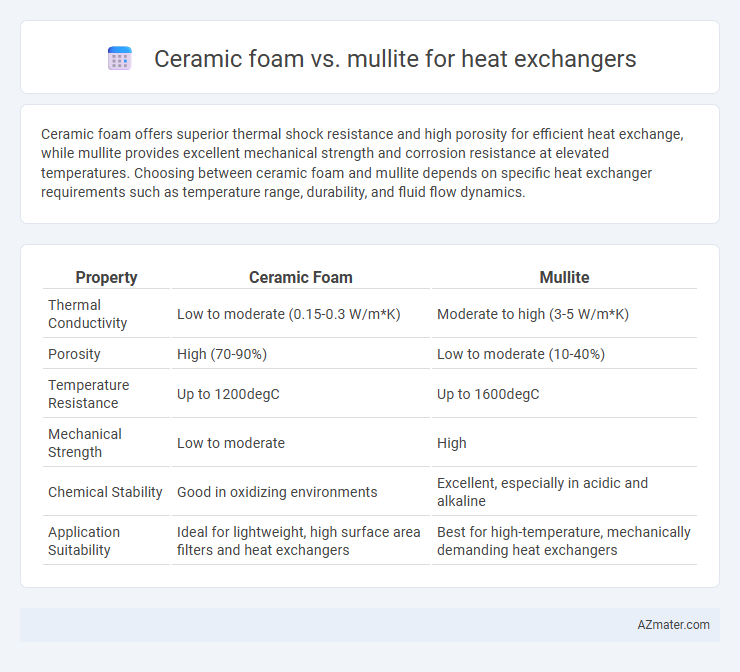Ceramic foam offers superior thermal shock resistance and high porosity for efficient heat exchange, while mullite provides excellent mechanical strength and corrosion resistance at elevated temperatures. Choosing between ceramic foam and mullite depends on specific heat exchanger requirements such as temperature range, durability, and fluid flow dynamics.
Table of Comparison
| Property | Ceramic Foam | Mullite |
|---|---|---|
| Thermal Conductivity | Low to moderate (0.15-0.3 W/m*K) | Moderate to high (3-5 W/m*K) |
| Porosity | High (70-90%) | Low to moderate (10-40%) |
| Temperature Resistance | Up to 1200degC | Up to 1600degC |
| Mechanical Strength | Low to moderate | High |
| Chemical Stability | Good in oxidizing environments | Excellent, especially in acidic and alkaline |
| Application Suitability | Ideal for lightweight, high surface area filters and heat exchangers | Best for high-temperature, mechanically demanding heat exchangers |
Introduction to Heat Exchanger Materials
Ceramic foam and mullite are critical materials in heat exchanger design, offering exceptional thermal stability and corrosion resistance at high temperatures. Ceramic foam provides a porous structure that enhances heat transfer efficiency through increased surface area and improved fluid flow dynamics. Mullite, an aluminosilicate ceramic, combines low thermal expansion with excellent mechanical strength, making it suitable for applications requiring durability under thermal cycling conditions.
Overview of Ceramic Foam
Ceramic foam offers a highly porous structure with excellent thermal stability and corrosion resistance, making it ideal for heat exchanger applications requiring lightweight and efficient heat transfer. Its interconnected pore network significantly enhances surface area, promoting superior heat exchange while minimizing pressure drop. Compared to mullite, ceramic foam provides better thermal shock resistance and durability in aggressive environments, optimizing energy efficiency and operational lifespan.
Overview of Mullite
Mullite is an alumino-silicate ceramic known for its excellent thermal stability, low thermal conductivity, and high resistance to thermal shock, making it ideal for heat exchanger applications. Its chemical formula, 3Al2O3*2SiO2, provides superior mechanical strength and corrosion resistance compared to traditional ceramic foams. Mullite's interconnected porosity ensures efficient heat transfer while maintaining structural integrity under high-temperature conditions.
Thermal Conductivity Comparison
Ceramic foam typically exhibits lower thermal conductivity, ranging from 0.3 to 1.0 W/m*K, making it an excellent thermal insulator for heat exchangers requiring efficient heat retention or controlled heat transfer. Mullite, with thermal conductivity values around 3 to 5 W/m*K, offers superior heat conduction suitable for applications demanding rapid heat dissipation and durability under high-temperature conditions. The choice between ceramic foam and mullite depends on the specific heat exchanger design criteria, such as required thermal management and operating temperature range.
Mechanical Strength and Durability
Ceramic foam heat exchangers offer superior mechanical strength due to their interconnected porous structure, which enhances impact resistance and load distribution under thermal cycling. Mullite, a type of aluminosilicate ceramic, provides excellent durability with high thermal stability and resistance to corrosion, making it ideal for high-temperature environments. Despite mullite's robustness, ceramic foam materials often outperform in applications requiring lightweight and stress-tolerant heat exchangers.
Resistance to Thermal Shock
Ceramic foam heat exchangers exhibit superior resistance to thermal shock due to their porous structure, which allows rapid dissipation of heat and reduces stress accumulation. Mullite, while possessing excellent thermal stability and chemical inertness, is less tolerant to rapid temperature fluctuations because of its denser microstructure. The choice between ceramic foam and mullite hinges on the specific application's need for rapid thermal cycling and temperature gradient management.
Corrosion and Chemical Resistance
Ceramic foam heat exchangers exhibit excellent corrosion resistance due to their high porosity and stable oxide structure, making them suitable for aggressive chemical environments. Mullite, composed primarily of 3Al2O3*2SiO2, offers superior chemical stability and resistance to acidic and basic corrosive agents, ensuring long-term durability in harsh industrial conditions. Both materials outperform conventional metals in chemical resistance, but mullite provides enhanced structural integrity and longevity against corrosive degradation in high-temperature applications.
Manufacturing and Cost Considerations
Ceramic foam heat exchangers offer a lightweight structure with high porosity, enabling efficient heat transfer but involve complex manufacturing processes such as foam replication or direct foaming, leading to higher production costs. Mullite-based exchangers, composed of aluminum silicate ceramics, benefit from lower raw material costs and established sintering techniques, resulting in more cost-effective mass production while providing excellent thermal stability and corrosion resistance. Balancing manufacturing complexity and cost-efficiency, mullite remains preferred for large-scale applications, whereas ceramic foam is suitable for specialized uses demanding enhanced heat transfer and lightweight design.
Applications in Industry
Ceramic foam and mullite are widely used in heat exchangers due to their exceptional thermal stability and corrosion resistance. Ceramic foam's porous structure enhances heat transfer efficiency and is ideal in gas-to-gas heat exchangers within the chemical and power generation industries. Mullite's high mechanical strength and thermal shock resistance make it suitable for high-temperature environments such as glass manufacturing and metal processing heat exchangers.
Which Is Better for Heat Exchangers?
Ceramic foam offers high porosity and excellent thermal shock resistance, making it ideal for applications requiring rapid heat transfer and durability under fluctuating temperatures. Mullite, with its superior thermal stability and low thermal expansion, provides enhanced structural integrity and longevity in high-temperature environments. Choosing between ceramic foam and mullite depends on specific operating conditions, where ceramic foam excels in lightweight, efficient heat exchange and mullite is preferred for long-term stability and resistance to thermal degradation.

Infographic: Ceramic foam vs Mullite for Heat exchanger
 azmater.com
azmater.com